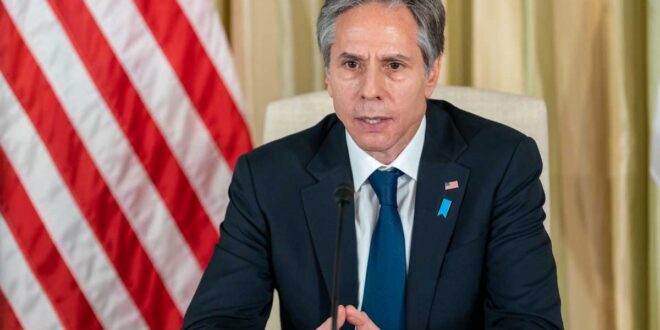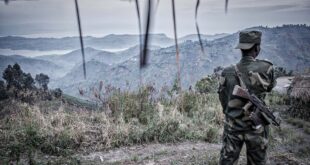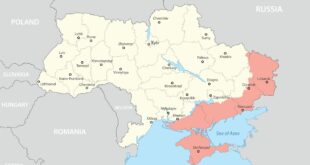James M. Dorsey
America to the rescue. In a twist of irony, that may be Central Asia’s only alternative, with the Russian invasion of Ukraine upsetting the region’s security apple cart.
The question is whether the United States, already rejiggering its commitment to security in the Middle East, has the will and wherewithal to engage.
Depending on one’s analysis of the Middle East’s strategic importance, the glass is either half full or half empty.
With the US wanting to focus on the Indo-Pacific, it has reduced interest in the Middle East. Yet, there is no cohesive Indo-Pacific strategy that fails to include the Arabian Sea, the Western mouth of the Indo-Pacific.
A similar argument could be made for Central Asia, a potential land-based counterpart to the maritime Indo-Pacific in Russia’s soft underbelly and China’s western flank.
The notion of an enhanced US security role in Central Asia and the Caucasus may seem far-fetched but no longer are the days when a Central Asian leader would invite Russia or the Russian-led Central Security Treaty Organisation (CSTO) to quell domestic unrest.
That’s what Kazakh President Kassym-Jomart Tokayev did in January 2022, a month before Russia invaded Uzbekistan.
The invasion has put in a different perspective long-standing Russian assertions that Kazakhstan is not a nation but “a Russian-speaking country in the full sense of the word.” That is President Vladimir Putin’s way of saying that Kazakhstan is part of the Russian world.
As a result, Central Asian leaders no longer see Russia as a trustworthy security guarantor and, worse, a potential threat. At the same time, regional leaders are hesitant to depend more on China than they already are economically. Theoretically, that leaves the United States as their only option.
Russia’s failure to secure free transit along the Lachin corridor linking the disputed autonomous region of Nagorno-Karabakh with Armenia, a fellow CSTO member, has deepened a lack of confidence in Russia.
Nagorno-Karabakh lies within Azerbaijan but has been under the control of ethnic Armenian forces backed by Armenia since a separatist war in the 1990s. That conflict also left large chunks of surrounding lands in Armenian hands.
In 44 days of fighting in September 2020, the Azerbaijani military routed Armenian forces This forced Armenia to accept a Russia-brokered peace deal that saw the return of a significant part of Nagorno-Karabakh to Azerbaijan.
Russia deployed nearly 2,000 peacekeepers to ensure safe transit across the region and monitor the peace deal.
But travel through the Lachin corridor has been blocked since December by Azerbaijanis identifying themselves as environmental activists and the opening last month of an Azerbaijani military checkpoint.
The Russian refusal to force the reopening of the corridor paved the way for renewed US mediation.
US Secretary of State Antony Blinken said last week that US-hosted talks in Washington between the Armenian and Azerbaijani foreign ministers had “discussed some very tough issues over the last few days and they’ve made tangible progress on a durable peace agreement. We really are within reach of an agreement.”
The effect of a successful mediation would ripple far beyond the southern Caucasus even if Russia has indicated that it would not accept an agreement that was not based on the 2020 Russian-brokered ceasefire.
Armenian Prime Minister Nikol Pashinyan was scheduled to visit Moscow this week to participate in celebrations of Russia’s victory in World War Two.
The US mediation comes as relations between Azerbaijan and Iran are deteriorating quickly while the former Soviet republic’s ties to Israel are expanding.
Mukhtar Mammadov arrived in March in Tel Aviv to take up his post as Azerbaijan’s first ambassador to Israel, even though the two countries established diplomatic relations 30 years ago.
On a visit to Baku last month, Israeli Foreign Minister Eli Cohen announced that his country would supply Azerbaijan with two satellites worth US$120 million. Israeli drones are believed to have played a crucial role in Azerbaijan’s victory in the 2020 war.
The Stockholm International Peace Research Institute identified Israel as Azerbaijan’s second-largest arms supplier after Russia between 2011 and 2020.
Haaretz newspaper reported in March that Azerbaijan’s Silk Way Airlines had operated 92 flights to the Israeli southern airport of Ovda in the past seven years. The cargo airline is one of few operators authorised to transport explosives through Israeli airspace.
Iran sees the deepening of relations with Israel as part of a strategy to further isolate the Islamic republic by disrupting its trade with Russia and Central Asia. Russia and Iran are both seeking to evade crippling US sanctions.
It also fears that Azerbaijan may allow Israel to use its airbases and/or airspace for a potential strike against Iranian nuclear facilities.
In his first interview after arriving in Tel Aviv, Mr. Mammadov denied that Azerbaijan would facilitate an Israeli attack.
Days later, Mr. Cohen said at the opening of the embassy in the presence of his Azerbaijani counterpart, Jeyhun Bayramov, that the two countries had agreed to form a “united front against Iran.”
Iran also worries that Israeli agricultural companies that have created ‘smart villages’ in areas close to its border captured by Azerbaijan during the 2020 war can eavesdrop on the Iranians.
In March, the Israel Institute of Technology or Technion helped Azerbaijan establish a cybersecurity center in Baku.
Iran is further concerned that a planned corridor connecting Azerbaijan and its Nakhchivan enclave inside Armenia to Russia and Turkey could change the Iranian-Armenian border.
“This corridor crosses the border of Iran with Armenia, and its implementation means removing Iran from the geopolitics of the Caucasus,” said a Tehran-based foreign policy analyst.
“Iran’s way to Europe is through Armenia, Azerbaijan, and Turkey. If Armenia’s (Nakhchivan) province also falls into the hands of Azerbaijan, it will officially become a big leverage… Iran will lose the whole of Central Asia, and this is a catastrophe for Iran,” the analyst added.
Iranian concerns are fuelled by hopes that closer cooperation with Russia will revitalise a two decade-old effort to create a 7,200 kilometre North South transport corridor, dubbed the International North-South Trade Corridor (INSTC), that would link India and the Gulf to Central Asia, Russia, and Europe.
Last month, Russia began exporting fuel to Iran by rail through Kazakhstan and Turkmenistan. In addition, trains have ferried 12 million tonnes of Russian grain via Iran to India.
Nevertheless, Azerbaijani-Iranian friction delayed plans to complete a 170-kilometre rail line that would link the Iranian provincial city of Rasht to the Azerbaijani border town of Astara, a key node in a trans-Caspian Sea route.
Meanwhile, Iran’s Islamic Republic of Iran Shipping Line Group has invested in a Russian port on the Volga River. At the same time, Iran is finalizing rules governing Iranian right of passage on the Volga and Don rivers.
To underscore its concerns, Iran has deployed troops and held military exercises on its border with Azerbaijan.
Heightening tensions, Azerbaijan and Iran expelled some of each other’s diplomats last week.
The expulsions followed an attack in January on the Azerbaijani embassy in Tehran in which a security guard was killed. In addition, there was an assassination attempt in March on Jan Fazil Mustafa, an Azerbaijani parliamentarian critical of Iranian influence.
Last November, Azerbaijan arrested several people on charges of spying for Iran.
On a visit to Central Asia in March, Mr. Blinken sought to capitalise on concerns about Russia and China and breathe new life into America’s relations with the Central Asian republics.
“We remain committed to standing for the sovereignty, the territorial integrity, the independence not only of Ukraine, but for countries across Central Asia and, indeed, around the world,” Mr. Blinken told journalists in the Uzbek capital Tashkent.
To make that commitment credible, the United States will have to do more than the US$50 million it allocated in 2022 and 2023 “to expand regional trade routes, establish new export markets, attract and leverage greater private sector investment.”
US$50 million pales compared to China and Russia’s billions of dollars invested in recent decades.
The US strategy seems to involve a division of labour in which the United States focuses on geopolitics while Europe is expected to increase its economic engagement with Central Asian states.
“Washington’s role as a powerful but distant and supportive friend to the region can help Central Asian countries achieve their stated goals of regional cooperation and a balanced, ‘multi-vector’ relationship with the outside world,” said Central Asia scholar Gavin Helf.
 Geostrategic Media Political Commentary, Analysis, Security, Defense
Geostrategic Media Political Commentary, Analysis, Security, Defense





